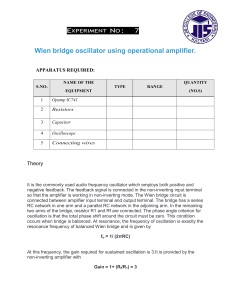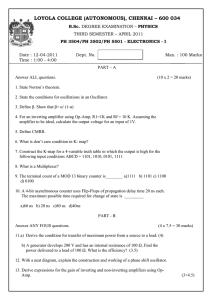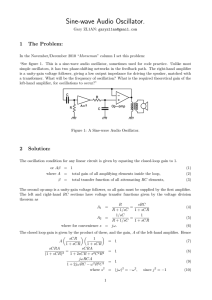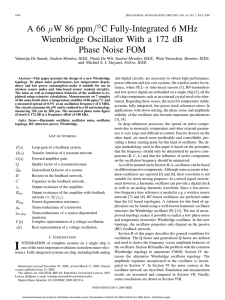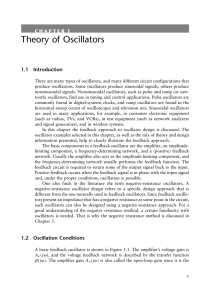Sinusoidal Oscillators
advertisement
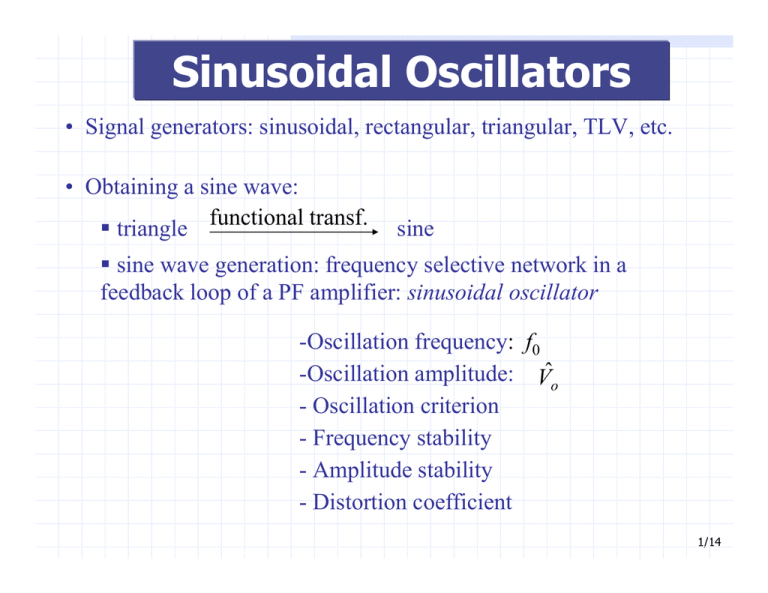
Sinusoidal Oscillators • Signal generators: sinusoidal, rectangular, triangular, TLV, etc. • Obtaining a sine wave: triangle functional transf. sine sine wave generation: frequency selective network in a feedback loop of a PF amplifier: sinusoidal oscillator -Oscillation frequency: f0 -Oscillation amplitude: Vˆo - Oscillation criterion - Frequency stability - Amplitude stability - Distortion coefficient 1/14 Oscillator feedback loop PF amplifier: xi = xs + xr a A= 1 − ar xs = 0; x0 − finit a ( jω ) A( jω ) = 1 − a ( j ω ) r ( jω ) 1 − a ( jω 0 ) r ( jω 0 ) = 0 2/14 Oscillation criterion Barkhausen’s criterion a ( jω 0 ) r ( jω 0 ) = 1 Signal reconstruction on the feedback loop a ( j ω ) = a ( j ω ) e jϕ a r ( j ω ) = r ( j ω ) e jϕ r a ( jω0 ) r ( jω0 ) = a ( jω0 ) r ( jω0 ) e j (ϕ a +ϕ r ) = 1 module condition: a( jω0 ) r ( jω0 ) = 1 phase condition: Who sets Vˆo ? ϕ a + ϕ r = 2 kπ gives a0 gives f0 Nonlinearity of the gain 3/14 a ( j ω ) r ( jω ) < 1 oscillations are attenuated - zero a ( j ω ) r ( jω ) > 1 oscillations are amplified - saturation Stability of the oscillation amplitude Automatic gain control vo = Vˆo sin 2πf 0t r ( jω ) = cst Vˆo ↑, a( jω0 ) ↓, Vˆ0 ↓ 4/14 RC Oscillators Basic amplifier independent of frequency: o • inverting ϕ r = −180 • noninverting ϕ r = 0 Frequency selective network BPF with one zero and two poles Phase shift of the network lies in the range of [+90o; -90o]. We want ϕ r = 0 just for a single frequency f0 It is necessary to bring closer the two poles. 5/14 WIEN Bridge For only one single frequency, f0 we have ϕr = 0 v r ( jω ) F ( jω ) = vo ( j ω ) output input 6/14 WIEN Bridge–cont. v r ( jω ) = r ( jω ) = vo ( jω ) ϕr = 0 1 ω0 Rs Cs − =0 ω0 R p C p 1 f0 = 2π Rs R p C s C p Rs = R p = R Cs = C p = C 1 Rs C p 1 + + j ω Rs C s − 1+ Rp Cs ωR pC p r ( jω 0 ) = 1 f0 = 2πRC 1 Rs C p 1+ + R p Cs 1 r ( jω0 ) = 3 7/14 7/14 Op amp and WIEN bridge oscillator vo (t ) = Vˆo sin 2πf 0t Rs = R p = R Cs = C p = C 1 a ( jω 0 ) = =3 r ( jω 0 ) R4 a =1+ R3 Vˆo = ? R4 1+ =3 R3 1 f0 = 2πRC 1 r ( jω0 ) = 3 R4 = 2R3 Nonlinearity on the gain, close to saturation 8/14 Automatic control of the amplitude 1. Using diodes for vo (t ) small, D1, D2 – (off) R4' + R4'' a =1+ R3 a ( jω 0 ) r ( jω 0 ) > 1 vo (t ) increases, D1 – (on) on the positive half-cycle D2 – (on) on the negative half-cycle R4' + R4'' || rd a =1+ R3 a ( jω 0 ) r ( jω 0 ) = 1 to maintain oscillations Vˆo is given by the value of rd 9/14 2. Using n-channel depletion-type MOSFET R4 a = 1+ ' R3 + rDS rDS ≈ 1 2β (vGS − VTh ) vGS<0 | vGS |↑, rDS ↓ 10/14 Op amp and RC ladder network oscillator • High pass band • Low pass band • the phase-shift is in the range of [0o; -90o] • inverting basic amplifier • how many identical RC cells are necessary to build an oscillator? 11/14 low pass RC ladder with 3 cells r ( jω ) = 1 2 3 1 − 5(ωRC ) + j 6ωRC − (ωRC ) [ ] ϕr = 0 6ω0 RC − (ω0 RC ) = 0 3 6 f0 = 2πRC 1 r ( jω 0 ) = − 29 12/14 The circuit of RC ladder network oscillator Why the basic amplifier does not contain only one inverting op-amp amplifier? 13/14 Illustration How does the voltages vo(t) and v+(t) look like in the steady-state regime? What is the oscillation frequency? Size R4 so that the circuit will maintain the oscillation. In conduction assume the equivalent diode resistance rD1=rD2=0,5 KΩ. Verify if the oscillation can start. How does the voltage vo(t) look like in the steady-state regime if D2 diode is mising in the circuit? 14/14
